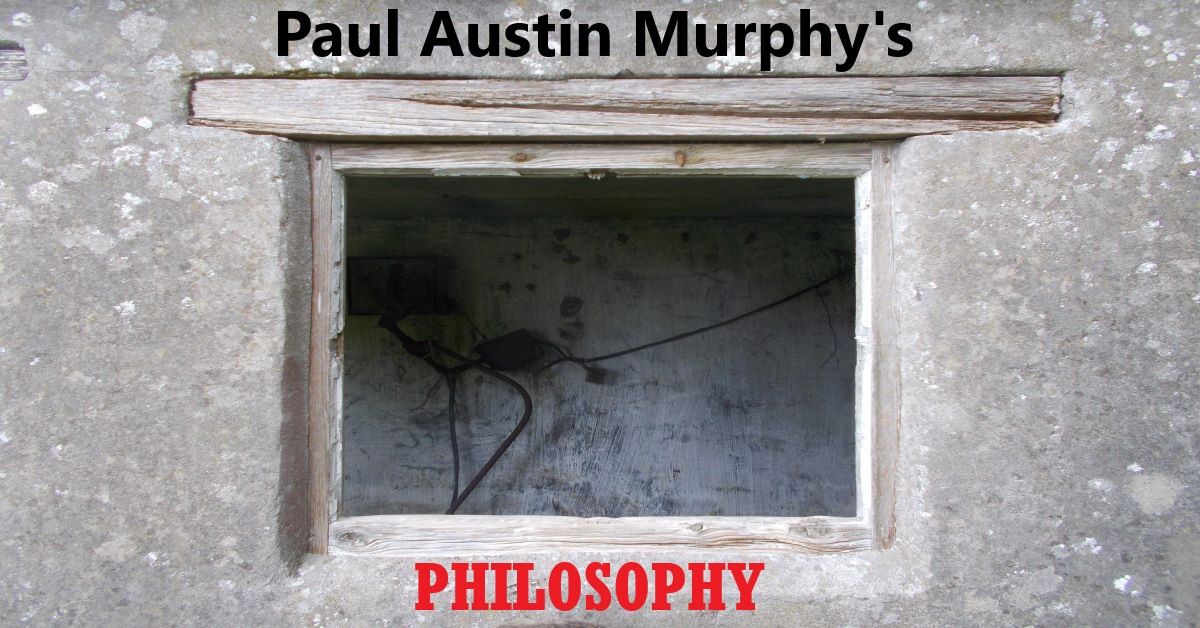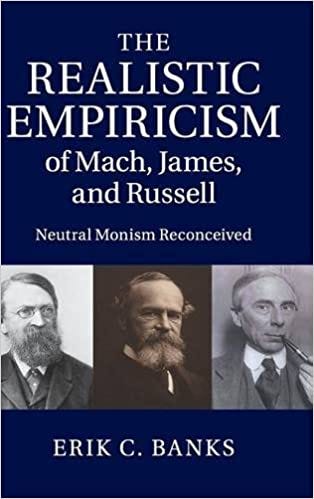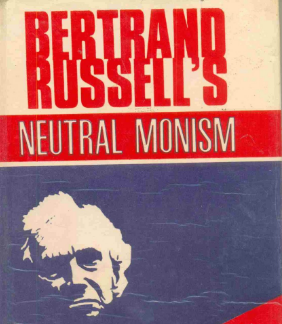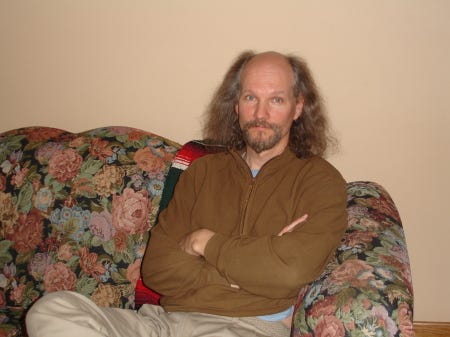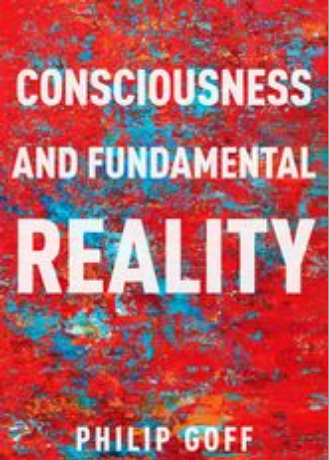The
prime difference between neutral monism and panpsychism is that
neutral monism reduces both the physical and the mental to what was
often called “neutral
stuff”.
Panpsychism, on the other hand, argues that experience is basic (or exists “all
the way down”).
That is, according to panpsychists, experiential properties aren't a
causal, physical or temporal consequence of basic neutral stuff: they
are there from the very beginning.
Having
said that, certain Russellian monists do believe that physical objects (even particles) are what is called “consciousness-involving”
(or “proto”?);
though it's difficult to work out what that hyphenated term means.
Because of that, this may mean that we have both “Russellian
panpsychism” and “Russellian
panprotopsychism”.
So
there's a clash here between seeing this neutral stuff as being
neither physical nor mental and seeing as actually having "phenomenal properties". Russellian monists appear (on the surface) to
have it both ways; whereas panpsychists don't.
Furthermore,
panpsychism doesn't appear to be reductionist. That is, in
panpsychism, the experiential
isn't reducible to something non-experiential. Neutral monism, on the
other hand, posits stuff (or objects) which has absolutely no phenomenal
properties at all (despite the aforementioned positions). This
goes squarely against panpsychism.
There
is of course a possible happy medium between neutral monism and
panpsychism: the position that every object (or thing)
has both a mental and a physical “aspect”
to it - whatever that may mean.
Why
“Neutral”?
The
term “neural” (as in “neural monism”) can be summed up in the
following manner. Many other monisms have claimed that “reality”
is grounded in either the physical or the mental. However, neutral
monism says that this stuff is neutral. That is, nature is neither “intrinsically mental” nor
“intrinsically physical”.
Having
said that, why is that stuff
said to be a neutral?
If neutral monism says that “ultimate reality” is neither
physical nor mental, then surely it isn't neutral
either. However, if neutral monism claims that the ultimate stuff is
something in between (or a mix of) the physical and the mental, then
that stuff would indeed be neutral (if still only in a manner of speaking).
What
is this “neutral stuff” anyway? The problem here is one of
characterising what this “one kind of stuff is”. Or indeed saying
anything
about it. And that's precisely why, for example, Stephen
Stich and Ted Warfield said
that it's “difficult to develop or understand the nature of the
neutral elements”.
So what
we often have here is philosophers saying what this neutral
stuff
isn't, not what it is. In other words, neutral stuff is like a
Kantian
noumenon
– i.e., it's hard to get hold of.
All this may be the case because these questions can't be answered until this neutral stuff is
“organised”.
Organising
Basic Elements/Stuff
Neutral
monists often talk in term of different ways of “organising” the
very same “elements” (or “substance”).
This
hints at a quasi-functionalist approach. Thus in very basic terms:
i)
When x
is organised in manner A,
then y
will result.
ii)
When the same
x
is organised in manner B,
then z
will
result,
Put
that way, neutral monism is hardly original or controversial. After
all, if a set of given atoms are arranged in manner A,
we get molecule y.
And when the same atoms are arranged in manner B,
we get molecule z. We can now move beyond atoms and molecules and
think in terms of systems (or simply of different complexes) too.
Whichever way a package of “elements” is arranged, it will
result is something different. (Interestingly or not, according to
mereological
universalism,
any random group of elements can be put together to create a new
object.)
So
it isn't a surprise that Bertrand Russell argued that everything
begins with “primal stuff”.
It's
also the case that this emphasis on the organising of basic stuff may
have an impact on the notion of emergence. Indeed it may even be the
case that it can rule emergence out. Or, at the very least, it can
rule out strong emergence.
Having said that,
emergence doesn't seem to be escaped from in either neutral monism or
panpsychism.
One
argument is this:
However:
To put it very simply: even if a neuron/atom has experiences, its experiences are radically different to that of a human person. And it's the experiences (even if proto-experiences) of all these atoms/neurons which are supposed to “add up” to the experience of a human person. (See my 'Philip Goff on Big/Little Minds, Composition and Emergence'.)
If there is experience “all the way down”, then there's no need for (strong) emergence at the level of human mentality or consciousness.
However:
Even if there is experience in every neuron (or in every atom in every neuron), then the overall consciousness of a human person still emerges from the “sum” (or “combination”) of all those “little minds”.
To put it very simply: even if a neuron/atom has experiences, its experiences are radically different to that of a human person. And it's the experiences (even if proto-experiences) of all these atoms/neurons which are supposed to “add up” to the experience of a human person. (See my 'Philip Goff on Big/Little Minds, Composition and Emergence'.)
What
are Noumena?
If
there's a single thing which complicates the attempt to square Kant's
noumena with intrinsic properties it's that some contemporary
philosophers believe that we have full access to a single set of
“intrinsic properties” – those instantiated in human
experience or consciousness. (See later references to Arthur
Eddington, Galen Strawson and Philip Goff.)
However,
in the most basic sense, Kant's noumena are almost the exact
equivalent of the intrinsic properties of contemporary analytic
philosophers – at least as they exist/occur in “external”
objects, forces, conditions, fields, etc. That is, just as noumena
were deemed to exist independently of the human senses or
observations, so that's also true of intrinsic properties. Of course
there is more to it than that.
We
can also tie Kant's “phenomena” to “extrinsic
properties”
in
a very similar way. That is, phenomena are “objects of the senses”
in the way that extrinsic properties are properties of observation,
relations, interactions, experiment and knowledge.
Finally,
noumena (in the Kantian scheme) are unknowable. It's also clear that
intrinsic properties are unknowable and insensible (except in the
case of the contents of consciousness – if that's accepted), which
is something that many philosophers who accept them are very happy to
admit.
I
just mentioned the fact that despite noumena being unknowable
and insensible, Kant did discuss them in detail. He did so because
noumena are “something that is thought [about]”. Similarly,
intrinsic properties are also things
which can be thought (about). In Kant's
own words
(from the Critique
of Pure Reason):
“... though we
cannot know these objects as things in themselves, we must yet be in
a position at least to think them as things in themselves; otherwise
we should be landed in the absurd conclusion that there can be
appearance without anything that appears.”
So
neither noumena nor intrinsic properties can be seen, observed,
etc., but both can be thought
about.
What's more, noumena and intrinsic properties assume a vital and
important position in both Kant's philosophy and in contemporary
(analytic) philosophy. In terms of Kant's own terminology, those whom
discuss intrinsic properties can be said to indulge in
“transcendental” reasoning. That is, despite a lack of
experiential or observational access to (external) intrinsic
properties, philosophers can still use their “reason” to make
connections between “phenomena” and (external) intrinsic
properties.
However,
one way in which the current views are not
Kantian is that what we observe, etc. aren't seen to be
“representations” of intrinsic properties. (Or, if they are, it's hard to see how that would work.)
Kant
makes his commitment to representations clear in the quote above when
he wrote about being
“landed in the
absurd conclusion that there can be appearance without anything that
appears”.
In
other words, we can't only have appearances or representations: things
must bring about appearances or representations. And those
things
are noumena.
In
contemporary philosophy, on the other hand, we don't have
representations (or even models) of intrinsic properties. They may
“ground” the “objects of the senses”; though they are never
represented. In the Kantian lingo again, intrinsic properties are
“Kantian objects” (or properties) - though without ever being
represented.
Intrinsic
Properties
It's
argued that there must be intrinsic natures. More specifically, it's
argued that there must be an answer to this Kantian question:
What
is the nature of this particle (or thing)
in and of itself?
This
isn't a question which of necessity must have an answer. Or,
alternatively, the way this thing
behaves, the relations it has, the structure/s it belongs to, etc.,
may well be all we have. One can therefore say that according to this
“relationalist”
logic, when the particle (or thing)
isn't behaving, interacting, etc., then it isn't a thing/particle at
all.
The
philosophical position of ontic
structural realism
takes this conclusion to its most extreme. James Ladyman and Don
Ross (two ontic structural realists) also provide us with a useful set of four positions which focus
on the nature of relations and “things”. Thus:
i)
There are only relations and no relata.
ii)
There are relations in which things are primary, and their relations
are secondary.
iii)
There are relations in which relations are primary, while things are
secondary.
iv)
There are things such that any relation between them is only
apparent.
It's
of course the case that Ladyman and Ross opt for i) above.
So
perhaps we should bite that bullet. In other words, the
“thing-in-itself” is like Wittgenstein's “idle
wheel in the mechanism”.
But that still leaves us with two questions:
i)
Do things-in-themselves exist?
ii)
Do things-in-themselves simply serve no purpose (i.e., even if they
do exist)?
This
takes us on to “dispositional essentialism”.
It's
very difficult to grasp what a “pure
disposition”
could be. Yet this is the position of those philosophers known as
“dispositional
essentialists”.
This position seems to replicate the position of some kinds of
structural realism (specifically ontic
structural realism again)
in which “things” are done away with and all we have left are dispositions, relations and structures (as
mentioned above).
Indeed dispositional essentialism can be seen as a position within
(scientific)
structural realism generally because it tallies with this position.
Ironically,
there is a certain strong sense in which it can be said that most
physicists are themselves ontic structural realists (without
them, of course, ever using that term or even philosophising about
this issue). After all, the mathematical physicists who discuss these
issues often say (in a roundabout way) that one can fully describe a
particle purely by its behaviour, not by its “inner
non-relational nature”.
More specifically, if we take electrons, we can say that they are
fully characterised in terms of how they can have positive or
negative gravitational effects on other particles or in
terms of other “behavioural” (or “dispositional”) features.
The physicist Lee Smolin puts similar
points
(from his Time
Reborn)
in the following:
“In
the Standard Model of Particle Physics... the properties of an
electron, such as its mass, which determines how much force is needed
to change its motion. In the Standard Model, all the particles'
masses arise from their interactions with other particles and are
determined primarily by one – the Higgs particle. No longer are
there absolutely 'elementary' particles; everything that behaves like
a particle is, to some extent, an emergent consequence of a network
of interactions.”
To
simplify. Particles have no “parts” (as Smolin puts it
elsewhere). However, they do indeed have “properties”. These
properties are all “relational” (or the product of
“interactions”). Mass, for example, is a relational property in
that a particle's mass is a product of its interactions with other
particles – primarily with the Higgs
boson.
Consequently, Smolin sees such things in “emergent” terms.
So a particle can be taken to a fundamental part of the world.
Mathematical physicists then tell us how this particle behaves (as we've
seen) and what structures it belongs to (these structures are themselves partly defined in
terms of “relations” and “interactions”).
So
that's relationism in physics.
Now
we can tie instrinsicalism
(rather than relationism) to both mind and panpsychism.
Panpsychists
also tell us about a particle's “intrinsic nature”; which is
seen as experience, consciousness or “phenomenal properties”.
The
philosopher Philip Goff goes further than this. He sets up a very
strong link between the minds of human persons and what panpsychists
say about particles. Firstly, we have “immediate access” to intrinsic properties in our own case. Thus (according
to Galen Strawson) the English astronomer, physicist and mathematician, Arthur
Eddington
(1882 – 1944),
argued
that it was “silly” to argue that we have access
to “external” matter; though not to the intrinsic properties of
our own minds. Indeed Eddington reversed this in the following quote
(from his 1928 The
Nature of the Physical World)
in which he argued for a “mind stuff” which unifies mind and
matter:
"We
are acquainted with an external world because its fibres run into our
own consciousness; it is only our own fibres that we actually know;
from these ends we more or less successfully reconstruct the rest, as
a palaeontologist reconstructs an extinct monster from its
footprint."
And
elsewhere:
“The
mind-stuff of the world is, of course, something more general than
our individual conscious minds... It is necessary to keep reminding
ourselves that all knowledge of our environment from which the world
of physics is constructed, has entered in the form of messages
transmitted along the nerves to the seat of consciousness... It is
difficult for the matter-of-fact physicist to accept the view that
the substratum of everything is of mental character. But no one can
deny that mind is the first and most direct thing in our experience,
and all else is remote inference.”
Believing
the contrary also leads to an “explanatory gap” (to use a
well-known phrase) between matter and experience. In addition, we
also have the huge problem of explaining where experience (or
consciousness) comes from in the first place.
Thus
what the believers in intrinsic properties believe is that despite
these “dispositional properties” (which mathematical physics
deals with), there must also be “intrinsic
categorical properties”.
Intuitively, that may seem correct. After all, surely something
must account for dispositional properties. What's more, Torin Alter
and Yujin Nagasawa
claim that Bertrand Russell, for example, accepted such intrinsic
properties. They say Russell argued
that
“matter
has intrinsic properties that both constitute consciousness and serve
as categorical bases for the dispositional properties described in
physics”.
Yet
these intrinsic properties (at least those of neutral monists) seem
also to be like (or actually be!) Kantian noumena
– that is, both unknown and unknowable. And precisely because of
that, many physicists and some philosophers either have no time for
them or claim that they don't so much as exist.
